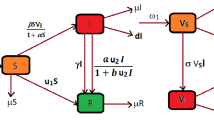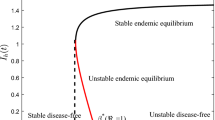Abstract
In this paper, a mathematical model on transmission of Japanese Encephalitis disease has been developed considering some control parameters and time-dependent environmental-carrying capacity. Here, the total vector population is divided into two subpopulations such as susceptible mosquito and infected mosquito. Here also, total reservoir population (i.e., the population in which the encephalitis virus grows) such as pig, horse, etc., has been considered which is divided into three subpopulations such as susceptible reservoir, infected reservoir and recovered reservoir. Total human population is also divided into three subpopulations such as susceptible human, infected human and recovered human. The dynamical behaviors of the system have been investigated. Here, the basic reproduction number associated with the system has been analyzed with respect to control parameters both theoretically and numerically. The biological feasible equilibria and their stability properties have been discussed and the existence condition of the disease has been illustrated numerically. For a certain set of parametric values, effectiveness of control parameters of our proposed model has been checked numerically. At last, Hopf bifurcations have been made numerically without considering control parameters for the case of constant environmental-carrying capacity of mosquito.










Similar content being viewed by others
References
Bandyopadhyay B, Bhattacharyya I, Adhikary S, Mondal S, Konar J, Dawar N, Biswas A, Bhattacharya N (2013) Incidence of Japanese Encephalitis among acute encephalitis syndrome cases in West Bengal, India. BioMed Res Int 2013:1–5. doi:10.1155/2013/896749
Erlanger TE, Weiss S, Keiser J, Utzinger J, Wiedenmayer K (2009) Past, present, and future of Japanese Encephalitis. Emerg Infect Dis 15(1):1–7
Freedman HI, Ruan S, Tang M (1994) Uniform persistence and flows near a closed positively invariant set. J Dyn Diff Equ 6(4):583–600
Gromowski GD (2014) Japanese encephalitis virus vaccine candidates generated bychimerization with dengue virus type 4. Vaccine 32:3010–3018
Keiser J (2005) Effect of irrigated rice agriculture on Japanese encephalitis, including challenges and opportunities for integrated vector management. Acta Trop 95(1):40–57
Le Flohic G, Porphyre V, Barbazan P, Gonzalez JP (2013) Review of climate, landscape, and viral genetics as drivers of the Japanese Encephalitis virus ecology. Plos Neg Trop Dis 7(9):e2208
Li MY, Muldowney JS (1996) A geometric approach global stability problems. SIAM J Math Anal 27(4):1070–1083
Lindahl JF, Stahl K, Chirico J, Boqvist S, Thu HTV, Magnusson U (2013) Circulation of Japanese encephalitis virus in pigs and mosquito vectors within Can Tho City, Vietnam. Plos Neg Trop Dis 7(4):e2153
Lutambi AM, Penny MA, Smith T, Chitnis N (2013) Mathematical modelling of mosquito dispersal in a heterogeneous environment. Math Biosci 241(2):198–216
Mukhopadhyay BB, Tapaswi PK, Chatterjee A, Mukherjee B (1993) A mathematical model for the occurence of japanese Encephalititis. Math Comput Model 17:99–103
Mukhopadhyay BB, Tapaswi PK (1994) An SIRS epidemic model of Japanese Encephalitis. Int J Math Math Sci 17(2):347–356
Naresh R, Pandey S (2009) Modelling and analysis of the spread of Japanese encephalitis with environmental effects. App App Math 4(1):155–175
Sengupta N, Basu A (2013) Japanese encephalitis virus infection: effect on brain development and repair. Curr Sci India 105(6):815–820
Sharma J, Kr Baruah M, Pathak A, Khan SA, Dutta P (2014) Epidemiology of Japanese encephalitis cases in Dhemaji district of Assam, India. Ann Biol Res 5(1):50–54
Singh A, Saxena SK, Srivastava AK, Mathur A (2012) Japanese Encephalitis: a persistent threat. Proc Natl Acad Sci Sect B Biol Sci 82(1):55–68
Tapaswi PK, Ghosh AK, Mukhopadhyay BB (1995) Transmission of Japanese Encephalitis in a 3-population model. Ecol Model 83:295–309
Thenmozhi V (2014) A first note on Japanese encephalitis virus isolation from Culex quinquefasciatus Say in Northern West Bengal. Int J Mosq Res 1(1):1–4
Thieme HR (1992) Epidemic and demographic interaction in the spread of potentially fatal diseases in growing populations. Math Biosci 111(1):99–130
Upadhyayula SM, Rao MS, Nayanoori HK, Natarajan A, Goswami P (2012) Impact of weather variables on mosquitoes infected with Japanese encephalitis virus in Kurnool district, Andhra Pradesh. Asian Pac J Trop Med 5(5):337–341
Van den Driessche P, Watmough J (2002) Reproduction number and subthreshold endemic equilibrium for compartmental models of disease transmission. Math Biosci 180:29–48
Author information
Authors and Affiliations
Corresponding author
Additional information
Communicated by Eduardo Souza de Cursi.
Rights and permissions
About this article
Cite this article
Panja, P., Mondal, S.K. & Chattopadhyay, J. Stability and bifurcation analysis of Japanese encephalitis model with/without effects of some control parameters. Comp. Appl. Math. 37, 1330–1351 (2018). https://doi.org/10.1007/s40314-016-0400-2
Received:
Revised:
Accepted:
Published:
Issue Date:
DOI: https://doi.org/10.1007/s40314-016-0400-2
Keywords
- Encephalitis
- Epidemic model
- Global stability
- Time-dependent environmental-carrying capacity
- Hopf bifurcation




